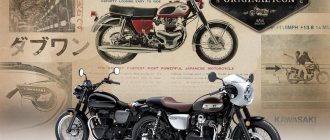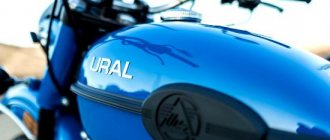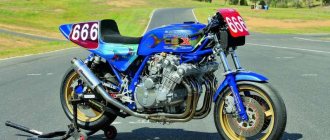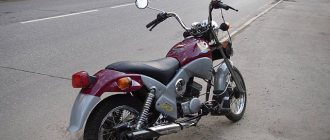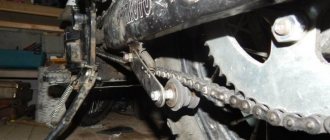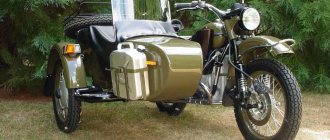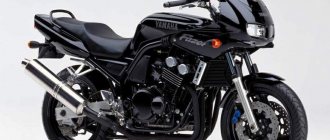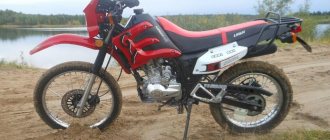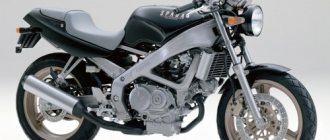History of motorcycles Minsk
3.18 / 5 (22 votes)
Motorcycle production in Minsk dates back to 1951. The prototype was the German model DKW RT125, which had been in service with the Wehrmacht since 1941.
By decision of the Allies, any enterprise that supplied weapons to the Wehrmacht was subject to dismantling. Therefore, as compensation for the damage caused to the national economy of the USSR, technical documentation and equipment from the DKW plant in the city of Zschopau were exported to the country. But there was still a lot of work - it was necessary to translate the documentation into Russian, select analogues from domestic materials, and organize the production of components.
The production of the RT125 model began in Kovrov (“K-125”) and in Moscow (“M1A”).
In 1951, the first Minsk motorcycle “M1A” was released - compact and single-seater, with an unsprung rear wheel - the shock was softened by two spiral springs of the saddle. At the front, a parallelogram fork with a single spring was used, and 19-inch wheels with stamped steel hubs. The engine cylinder was cast iron, a simple mesh air filter was equipped with a starting mesh air filter and a starting flap, and the electrical equipment included a DC generator and battery. The engine ran on A-66 gasoline and the transmission had three gears. On a nine-liter tank it was possible to travel up to 400 km, largely due to the lack of rear suspension, which limited the speed to 40-50 km/h (although the maximum speed was 70 km/h). The engine size (bore/stroke) was 52/58 mm, which has remained unchanged to this day.
The first motorcycles in Minsk were assembled from Moscow components, which explains the inscription “Moscow” on the gas tank. The M1A motorcycle (popularly dubbed the “Macaque”) even today looks proportionate and elegant, despite the absence of any cladding.
The success of the choice of prototype is evidenced by the fact that by 1950, eight factories in seven countries were producing copies of this German model. Including such famous motorcycle companies as BSA, Harley-Davidson, Royal Enfield and Yamaha. In Minsk, destroyed by the war, on November 6, 1945, a restored bicycle plant came into operation, the equipment for which was also exported from Germany. By order of the Ministry of Automotive and Tractor Industry of the USSR No. 494 of July 12, 1951, the production of the M1A motorcycle was transferred from Moscow to Minsk. This is how the Minsk Motorcycle and Bicycle Plant (MMBZ) appeared. The plant still operates today, and its commitment to the production of motorcycles has remained intact.
The modernized M1M motorcycle, which appeared in 1956, stood out for its original shape of deep welded fenders.
It received a pendulum suspension of the rear wheel with spring shock absorbers and friction dampers (vibrations were damped by dry friction between the washers). The parallelogram front fork gave way to a short-link pusher type with spring shock absorbers. Now the suspension has become very soft; it was even noted that on bad roads it worsened stability. Electrical equipment running on alternating current was used for the first time on a motorcycle. The engine power increased slightly due to changes in the manufacturing technology of purge channels in cast iron cylinders, an increase in the compression ratio and the use of a different carburetor. And the muffler lost the “fish tail” typical of pre-war motorcycles.
In 1961, the designers of the M-103 model summarized the design experience they had gained, experience in participating in sports competitions, and experience in long-term operation. The result was the “Humpbacked Horse,” on which a telescopic fork with “hydraulics” was installed. Hydraulic shock absorbers were also used in the rear wheel suspension. The wings are profiled again and are not as deep as before. Instead of a mesh air filter, a contact oil filter was installed, which significantly improved air purification and increased the durability of engine parts. It is believed that the M-103 was the simplest Minsk motorcycle. Although its load capacity was 150 kg, the seat was a single seat, the saddle and passenger footpegs had to be purchased separately.
When creating the M-104 motorcycle in 1964, special attention was paid to issues of technical aesthetics. The device now has side trims, a double seat, and a carburetor and filter casing. This car was the first to receive its own name “Minsk”. Engine power increased to 5.5 liters. With. due to an increase in the compression ratio and a modernized K-55D carburetor. At the same time, the engine, compared to its predecessors, lost its flexibility in characteristics (and the gearbox remained three-speed), which prompted the designers to develop a new engine.
In 1967, the M-105 model was released. In terms of the number of design changes and their labor intensity, the M-105 model has no equal among Minsk motorcycles. A new engine that produced a significant 7 hp at that time. With. and allowing acceleration to 80 km/h, became the base for subsequent models. Its main differences: an aluminum cylinder jacket with a cast iron liner poured into it, a new K-36M carburetor and muffler, and a four-speed gearbox. The main drive chain began to be covered with stamped casings with rubber covers. For the first time, a brake light was installed on the M-105, as well as a speedometer backlight. The frame was strengthened somewhat, but the rest of the chassis and hood components remained virtually unchanged. One of the M-105 models became the millionth Minsk motorcycle.
In 1971, the M-106 model was released; the cylinder and head with an increased fin surface and a new shaped gas tank stood out. The tank volume increased to 12 liters, and an emblem in the form of a stylized image of a stork appeared on the sides. The engine power was increased to 9 hp. With. due to better cylinder filling, new muffler and carburetor. Increasing power and increasing the maximum speed to 85 km/h required further strengthening of the frame and replacement of wheel bearings. For the first time, a trunk was installed, which later became a mandatory accessory for Minsk motorcycles. The weight of the car reached 100 kg.
Released in 1973, the MMV3-3.111 model stood out for its modern appearance thanks to the liquidity of the linings, the original shape of the gas tank, tool boxes and engine crankcase covers. Improvements also affected a number of other components and parts. Now aluminum wheel hubs were installed on motorcycles, and the wheels themselves came with a landing diameter of 18 inches. The air filter received a paper filter element, a central light switch and a direction indicator appeared. The motorcycle received the USSR Quality Mark. A small series was produced of the “Sport” modification, which was distinguished by a sports steering wheel with a jumper, an upper muffler and a front fender. The trunk and steering damper were removed from the motorcycle, an electronic ignition system was used for the first time on Minsk motorcycles and they switched to AI-93 gasoline, which provided a maximum power of 11.5 - 12.5 hp at a compression ratio of 12.
In general, the appearance of the MMV3-3.115 motorcycle, which appeared in 1976, has changed little compared to its predecessor. A new muffler, headlight and taillight have been installed. The central switch and speedometer were moved out of the headlight housing into separate housings. Since 1977, non-contact electric ignition with a KET-1 switch and a new K-62S carburetor began to be installed on the motorcycle. This made it possible to increase engine power without switching from AI-72 to higher octane gasoline. Since the MMV3-3.115 model, Minsk motorcycles have lost their steering damper forever, and rebound springs have appeared in the front fork. The MMV3-3.115 motorcycle is considered one of the most successful at the enterprise - it was produced for seven years.
1982 The MMVZ-3.112 motorcycle, which has remained virtually unchanged in appearance, has improved its consumer qualities in a number of ways. It became 7 kg lighter, the diameter of the brake drums increased to 150 mm. A new feature was the separation of the rear wheel hub from the sprocket - now when removing the wheel there was no need to remove the chain drive.
The modernization of 1984 most affected the electrical equipment system - they switched to a voltage of 12 V, and the generator power increased to 65 W. A voltage stabilizer appeared, combined with an ignition system switch, the so-called BKS. Control indicators for direction, high beam, and neutral gear appeared on the dashboard. The gear ratios in the gearbox have also been changed.
1986 ММВ3-3.112.11, this modification of the motorcycle was intended for use primarily in rural areas. The engine was derated to 10 hp. s., but at the same time it became more torquey at low speeds. Light traffic on rural roads was ensured by the main gear ratio increased to 3.07. The new muffler has been designed to raise the rear end for increased off-road capability. The raised front wing also served the same purpose. The gas tank lost its rubber lining, and a jumper appeared at the steering wheel.
The 1991 modification of the MMV3-3.112.12 motorcycle for rural areas was equipped with a new instrument panel and efficient single-tube gas-filled shock absorbers for the rear suspension.
The 1992 motorcycle MMB3-3.112.13 differed from its predecessors primarily in the front fork - the diameter of the supporting pipes increased to 35 mm, and the sliding pipes began to be made of aluminum alloy, the settings changed, and rubber corrugations appeared. The front “upper” wing became plastic, the muffler changed its shape, became thinner and longer, and the technology for its manufacture changed.
The 1994 modification MMV3-3.113 was the most heavily updated model of the M-105. For the motorcycle, a duplex wheel suspension frame, saddle, gas tank, rear fender, facings, and air filter were redesigned. The front fork and muffler were carried over from the 3.112.13 model introduced several years ago. The driver's position has changed - the height of the saddle has increased. We used a cable drive for the rear brake. The engine's crankcase, cylinder, and cylinder head were redesigned, and a new design generator was installed - a flywheel. The engine power (the same size 52/58 mm as the M1A) reached 13 hp. s., this highest figure for all serial Minsk models made it possible to overcome the symbolic speed mark of 100 km/h.
1996, MMV3-3.113.1, an outwardly indistinguishable modification received an engine that, in order to improve performance at low speeds, was derated to 10 hp. With.
In 1999, the MMV3-3.112.14 model was released, a motorcycle with the name “Sputnik” was a modification of the 3.112.12 model and differed from it in the headlight (later a rectangular headlight with a halogen lamp and an Iranian-made fairing was installed on it). The muffler is borrowed from the “one hundred and thirteenth” model.
MMV3-3.114 of 2003 became the first Minsk motorcycle with a four-stroke engine. This 125 cm3 engine was equipped with an electric starter, the transmission was a five-speed gearbox and an open chain drive located on the left. A monotube frame was designed for the engine, which has a pedigree from the Honda CB125. In addition to the engine, the MMV3-3.114 differed from the MMV3-3.113.5 by inclined rear shock absorbers, an imported air filter with a foam filter element, and a muffler. The brakes on both wheels remained drum brakes; in 2008, a disc brake was installed at the front. In recent years, the model has been called MINSK C4 125.
The 2005 MMV3-3.113.4 motorcycle was designed for use in forestry. It had increased off-road capability due to increased suspension travel (due to raked rear shock absorbers), and the layout allowed for a rear tire with wider tread. A special feature of the motorcycle is its numerous attachments: an enlarged rear trunk, side and front racks, a removable passenger seat, crash bars, headlight and front turn signal protection. Cassettes for fire extinguishers and driver hand protection were optionally available.
2006 MMV3-3.113.8, this modification differs from 3.113.5 by inclined rear shock absorbers, a raised muffler and plastic side trims. Instead of imported components (headlight, fairing, wing, etc.), domestic ones were used. In recent years, the model has received the designation MINSK C125.
The design of the motorcycle in 2008 MINSK M4 200 was made in a classic style; customizer Yuri Shif had a hand in the appearance. The installed engine is a 200 cc engine produced by the Chinese company Zongshen. The retro motorcycle attracts with its simplicity and traditionality combined with elegance of form.
In the latest models, since 2008, 52 changes have been made to the classic models, after which they received new names - “C125”, “M125”, “M125X”, etc. Including: restyling was carried out and the color range of motorcycles was expanded, painting technology was improved, the engine and gearbox were improved, a new flywheel-type generator with increased power was installed. Motorcycles are equipped with new chains, light elements, and wind shields. At the customer's request, the front wheel is equipped with a disc brake.
MINSK M125 2009, in fact it is the MMVZ-Z.112.15 “Pioneer” produced since 1999, equipped with a front disc brake and with minor changes in the configuration. A stork flew away from the emblem on the gas tank.
The classic 2010 MINSK X200 SUV will appeal to novice motorcyclists. Nothing superfluous - just the essentials for conquering dirt roads and forest trails. The presence of lighting equipment and dual-use tires allows you to move comfortably on public roads.
The 2011 MINSK C4 250 is built on a completely new platform, it has a modern appearance, alloy wheels and dual-disc front brakes.
MINSK R250 2012 is a development by Megelli, introduced into production without simplification or reduction in cost.
The engine is water-cooled and has a six-speed gearbox.
It is estimated that over the 60 years of the company’s existence, more than 6.5 million motorcycles were sold. And this figure is not final; the management and employees of the enterprise are optimistic about the future.
The lineup
In Soviet times, the Minsk model range could not boast of much variety.
But those years have passed and today’s “Minsk” is a wide model range consisting of 10 road motorcycles, 10 sports models, as well as enduro motorcycles, scooters, ATVs, snowmobiles and mopeds.
The classic line under the popular pseudonym “macaque” has been expanded to 6 variations, which are produced to this day.
Now, in order to give a better description of some of the “Minsk residents,” let’s look at several of the most popular and sought-after models.
You will find the most popular models of children's gasoline motorcycles in our article.
From our photo review you will find out what the Yamaha YZF-R1 racing motorcycle from the Japanese manufacturer looks like.
"Road worker" 125
This motorcycle is a typical road bike that has retained the classic lines and functionality that makes fans of this brand so happy.
The model was equipped with a 4-stroke engine with a volume of 125 cm³ and a 5-speed gearbox.
Minsk 125 is presented in a two-color version, which allows the consumer to choose. The design was complemented by cute stickers that nicely complement the appearance of the bike.
Unfortunately, the model does not contain a tool box, which can cause a number of difficulties when traveling.
Of the security systems, the 125 was only equipped with a steering lock, which does not make it secure at all. Just unscrew a couple of bolts and you can safely take the motorcycle away.
Despite its apparent simplicity, the bike is in wide demand not only in Belarus, but also in the territories of other countries of the former Soviet Union.
In this article you can not only see a photo of the Japanese motorcycle Honda CB 400, but also get acquainted with its technical information. characteristics.
We present to your attention a small photo selection of the Kawasaki Ninja 250R motorcycle.
Sports bike R 250
In 2011, the attractive, elegant M1NSK R 250 sports bike rolled off the factory assembly line.
Everything would be fine if not for one circumstance - the sport bike turned out to be an exact (but less expensive) copy of the Migelli R250, presented by English specialists.
Belarusians have been cooperating with the brand’s English engineers for a long time and were able to buy the rights to produce the motorcycle.
The motorcycle created a real sensation on the market - of course, because the concern had never produced anything like it. The slightly modified design has become more aggressive.
The characteristic black and red coloring makes the bike look like a “hellish messenger”.
Under the chic body, the manufacturers hid a 249 cc, single-cylinder engine with a capacity of 25 “horses”.
For such an aggressive design and impressive appearance, this is very little - the bike can only accelerate to 145 km/h.
The materials used for the production of the case are distinguished by excellent strength characteristics and lightness, which is good news.
The weight of the bike is only 129 kg.
Photo gallery
Even though all M1NSK motorcycle models are not particularly powerful, they have earned popularity among the people due to their low cost, maintainability and reliability. The updated line of the Belarusian brand is in our small photo selection.
Price policy
Minsk motorcycles have always been distinguished by their affordable prices, and the updated brand did not deviate from this trend.
Thus, the simplest model under the symbol D4 125 can be purchased for 46 thousand rubles.
If you take a 125 sport bike, it will cost you 100 thousand rubles.
To summarize briefly, the Minsk motorcycle models remain reliable, functional, and most importantly, inexpensive.
The line is more aimed at the novice biker and those who like to ride around the city at low speeds. Unfortunately, the plant does not produce powerful motorcycles.
